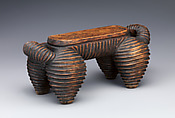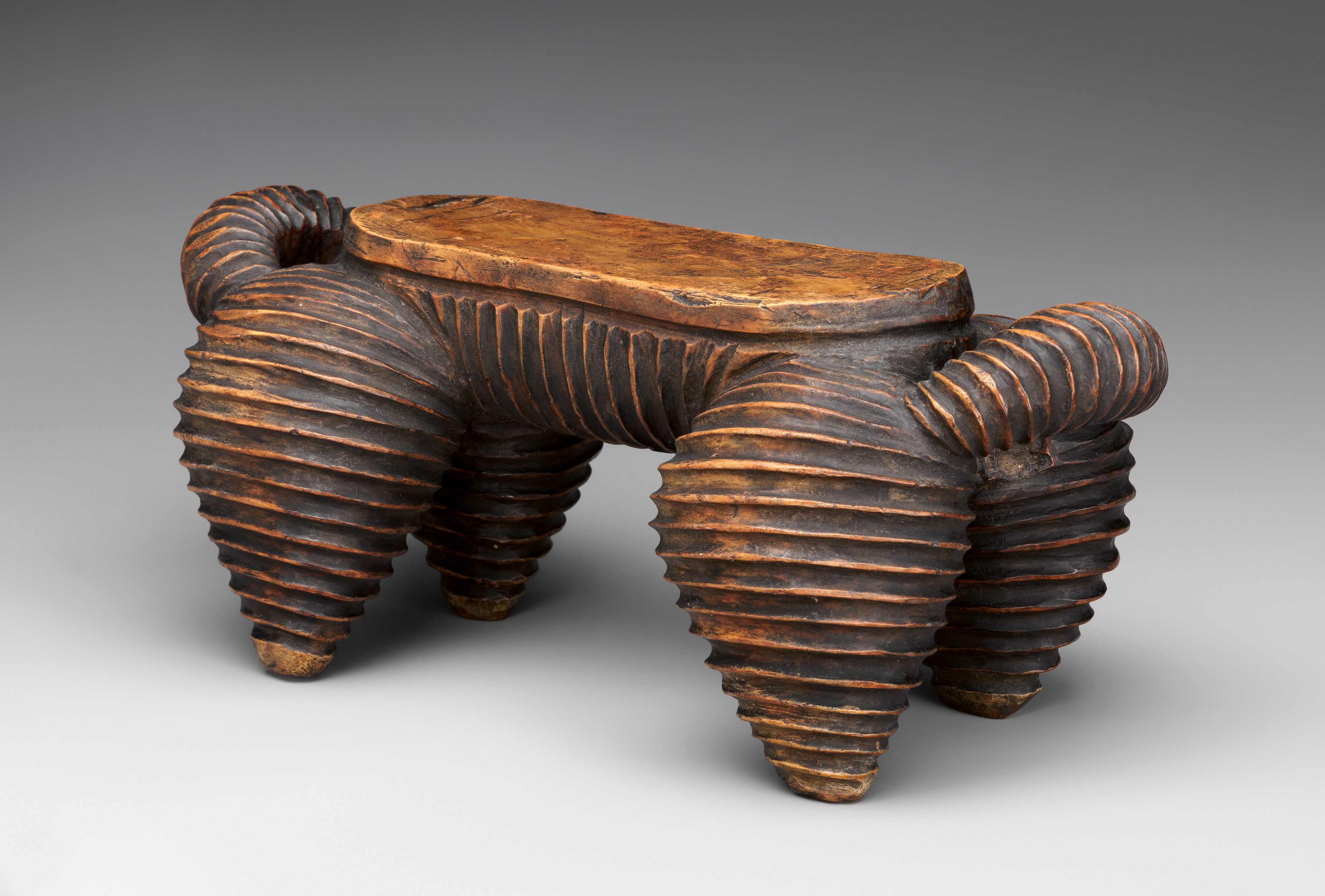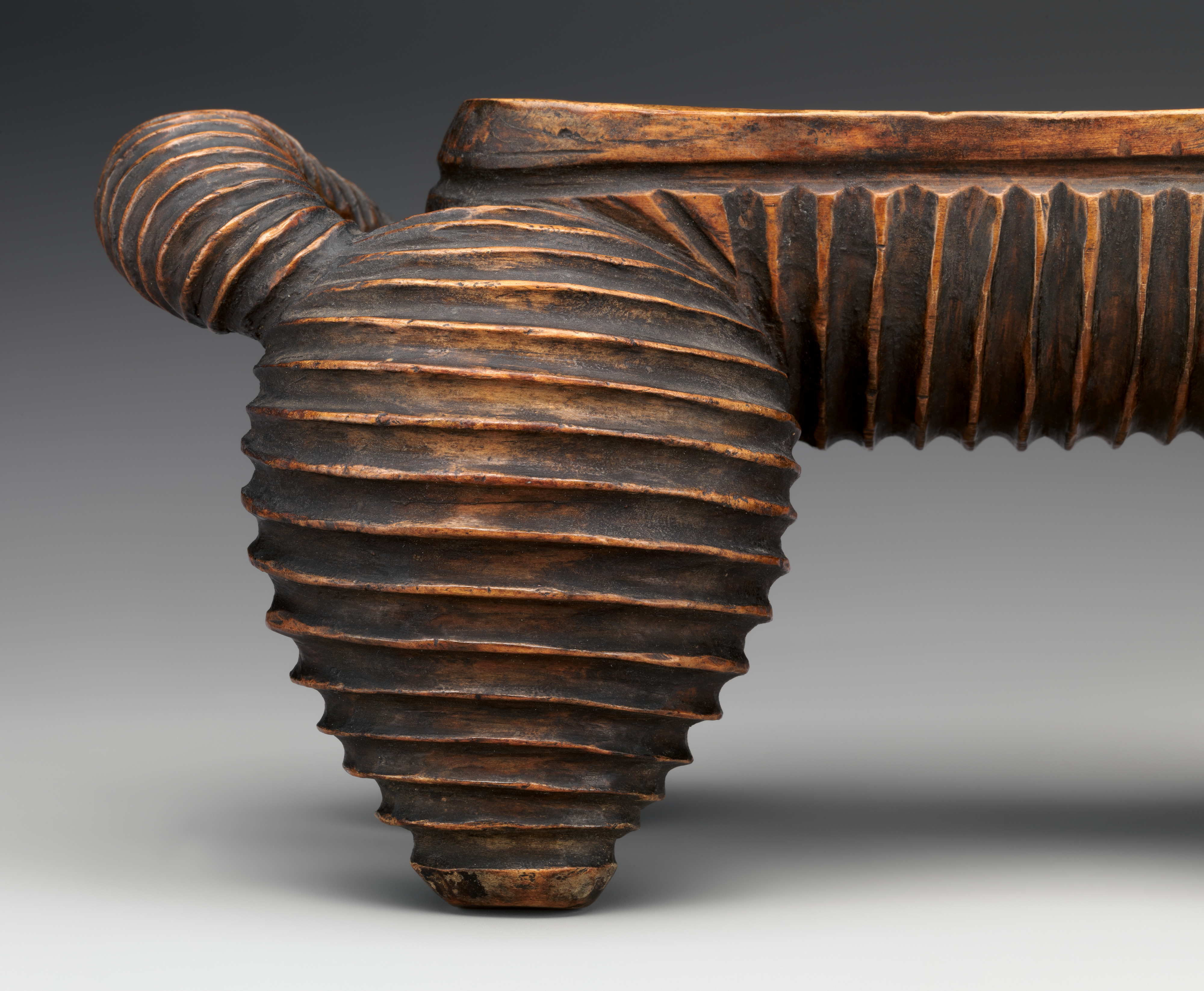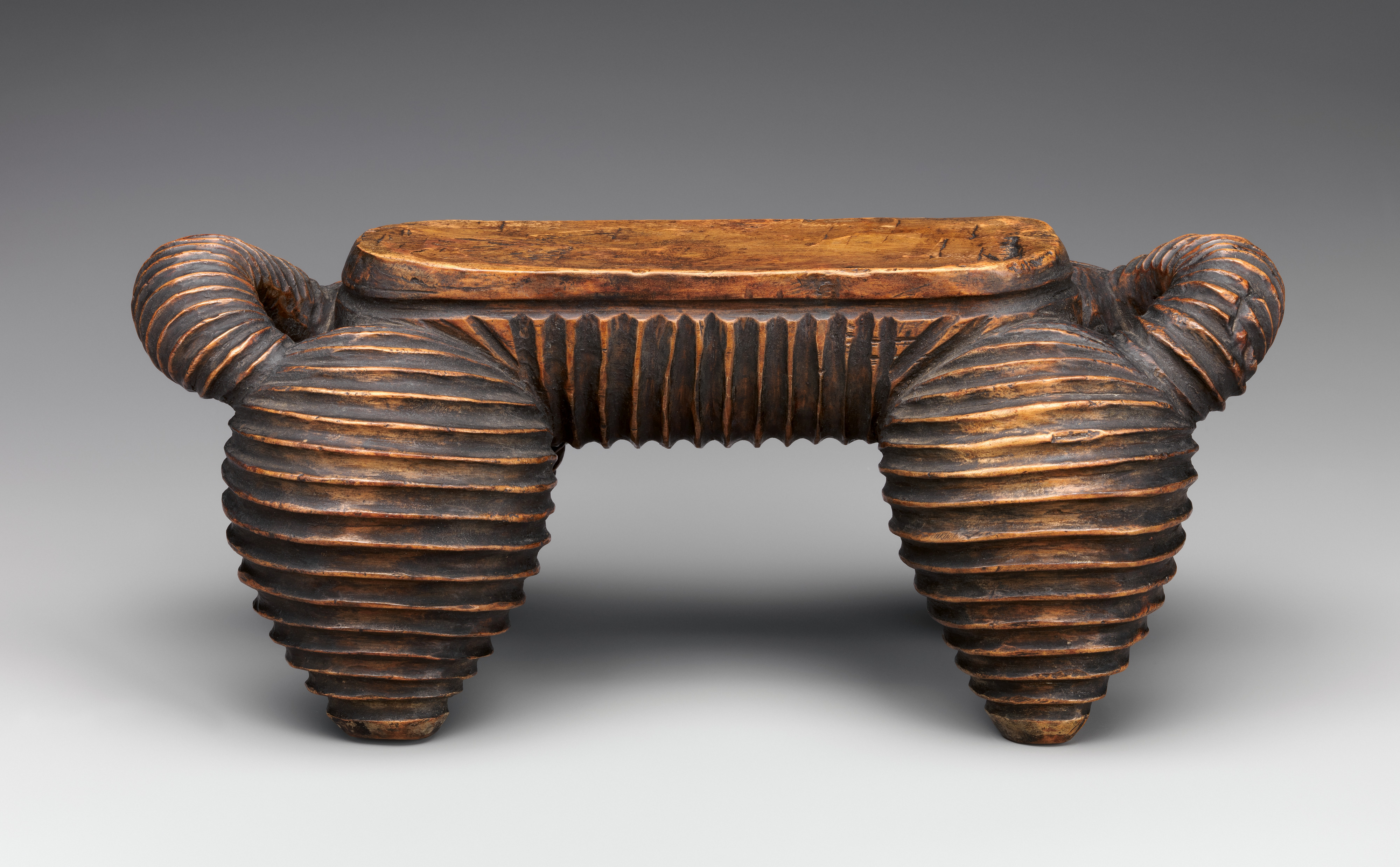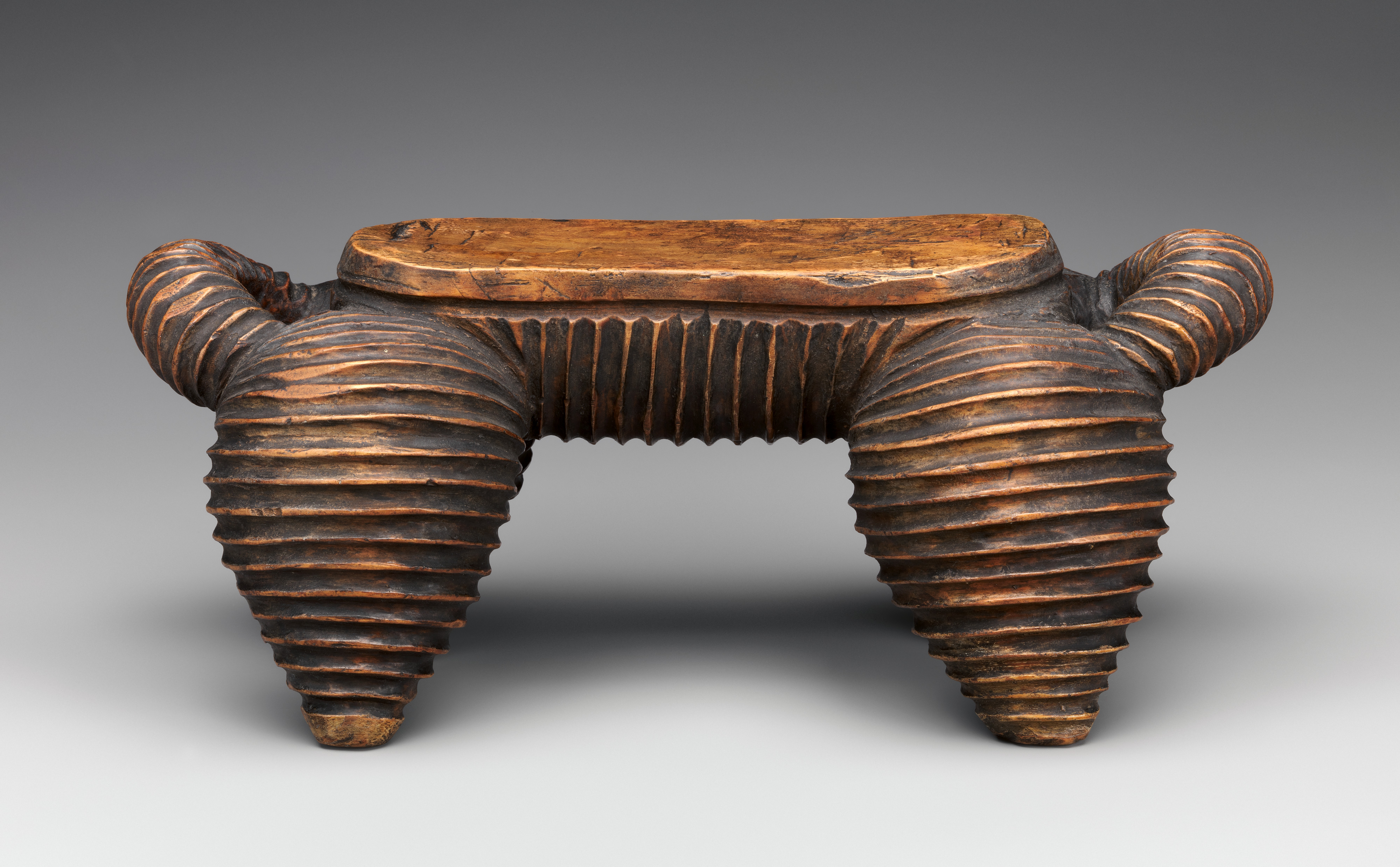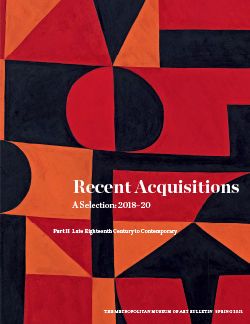Headrest
Not on view
This headrest has a horizontal orientation with four legs supporting a platform, semi-circular in profile, which is contained between the legs. The surface is flat, and there are rounded handles at either end that are slightly raised above the horizontal line of the platform. The form falls into a category of headrest commonly found south of the Zambezi River that do not have a columnar base (Nettleton, 2007: 247). The four bulbous legs evoke a fat and healthy quadruped—most likely a cow, given the vital significance of this animal in Nguni society. The surface of the legs, handles, and underbelly is decorated with deeply incised grooves that wrap around the form in parallel lines, creating a dramatic surface of smooth ridges that are shiny from handling and soft curves that are dark with patina. The top is undecorated, and the honey color of the wood is visible in contrast to the decorated areas, which are black with surface accretions.
Headrests have been recorded in art traditions across Africa. More headrests have been collected from southern African peoples than in other regions of Africa (Nettleton, 2007: 247). Among the Nguni peoples, headrests have served to protect elaborate coiffures that can relay the status, gender, and age of the wearer. The designs developed by regional carvers are remarkably diverse in both form and style—see, for example, this elegant example in the Met's collection that features a storage compartment for the owner's valuables (2000.160.53a, b).
The distinctive style of this headrest—especially the surface patterning—allows us to attribute it to a known group of sculptors, active in the mid-nineteenth century in the vicinity of the former British colony of Natal, near present-day Durban, Kwa-Zulu Natal, South Africa (Catherine Elliot, personal correspondence, 11/04/18). Both regionally and internationally renowned for their skills in wood carving, these sculptors produced artwork for a local elite including the Zulu king Mpande kaSenzangakhona (r.1840–1872). In a celebrated illustration by George French Angas, Mpande kaSenzangakhona is depicted in state with a number of wooden carvings at his feet, including a headrest that closely resembles this example (Angas, 1849: pl.11).
Carved wooden objects were also made specifically for sale to Europeans, especially the British, who were an increasing presence at Port Natal from the 1820s onwards. Nguni sculpture was subsequently exhibited in Europe at world fairs such as the International Exhibition, held in London in 1862, which intended to showcase the fine arts of all nations, following the example of the Great Exhibition of 1851 (Elliott, Cartwright and Kevin, 2013: 18). This headrest is part of a defined corpus of known works, including the monumental vessel acquired by the Metropolitan in 2013 (2013.164a, b) which is one of the most impressive in the group. While at least a dozen lidded vessels are recorded in museum collections, only a single headrest of this style is known beyond the one illustrated by Agnas as being in the possession of Mpande kaSenzangakhona. A vastly inferior example conserved in the Musée du quai Branly, Paris (71.1935.54.98).
James Green, Ph.D.
The Sylvan C. Coleman and Pam Coleman Memorial Fund Fellow, 2017–2018
Further Reading
Angas, George French. 1849. The kafirs illustrated in a series of drawings taken among the amaZulu, amaPondo and amaKosa tribes ; also, Portraits of the Hottentot, Malay, Fingo and other races inhabiting Southern Africa ; together with Sketches of landscape scenery in the Zulu country, Natal and the Cape colony. London: Hogarth Press.
Elliott, Catherine, Caroline Cartright and Philip Kevin, ‘Maker, material and method: reinstating an indigenously made chair from Kwa-Zulu Natal, South Africa’ Technical Research Bulletin, British Museum, Vol. 7, 2013: 15 – 30. (http://www.britishmuseum.org/pdf/BMTRB_7_Elliott_Cartwright_and_Kevin.pdf)
Elliott Weinberg, Catherine ‘The Name of Zulu is Now Given’: Provenancing Objects from Colonial Natal in the British Museum’s Christy Collection’ in Leibhammer, Nessa, and Carolyn Hamilton. 2016. Tribing and untribing the archive identity and the material record in Southern KwaZulu-Natal in the late independent and colonial periods Voume 2, pp. 475 – 502.
Mann, Robert James 1862. A descriptive catalogue of the Natal contribution to the International Exhibition of 1862.
Nettleton, Anitra ‘Lidded Vessel’, in Musée du quai Branly, Yves Le Fur, David Radinowicz, Susan Schneider, and Sarah Kane. 2009. Musée du quai Branly: the collection: art from Africa, Asia, Oceania, and the Americas. Paris: Flammarion, 102.
Nettleton, Anitra C. E. 1991. "Tradition, authenticity and tourist sculpture in 19th and 20th century South Africa". Art and Ambiguity: Perspectives on the Brenthurst Collection of Southern African Art. 32-47.
Nettleton, Anitra 2008. African Dream Machines: Style, Identity and Meaning of African Headrests. Johannesburg: Wits University Press.
Due to rights restrictions, this image cannot be enlarged, viewed at full screen, or downloaded.
This artwork is meant to be viewed from right to left. Scroll left to view more.
